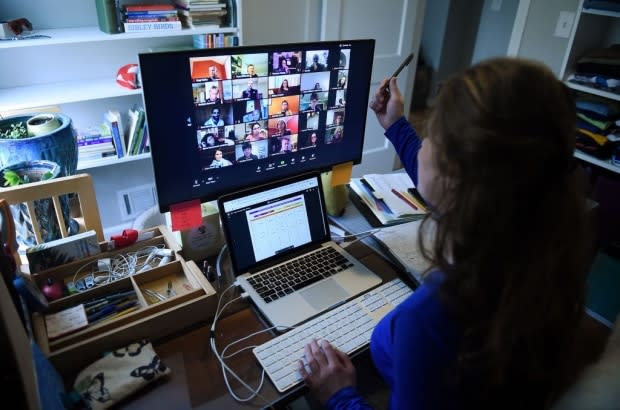Centralized virtual schools and synchronous delivery: How remote learning is shaping up for fall

Myriad Canadians got a rough introduction to online education when the pandemic closed classrooms this spring and forced educators into rapid implementation of "emergency learning at home."
Now, as Canadian school districts grapple with a physical return to class in September, many are making plans for remote instruction, too.
Thousands of families across Canada have opted to continue with distance schooling, but questions remain about what that will entail. We tried to find answers to some of them:
What will virtual school look like?
In different regions, districts are centralizing their virtual offerings. The Calgary Catholic School District, for example, created a whole new virtual elementary school named Saint Isidore, after the seventh-century scholar and bishop whom the late Pope John Paul II dubbed "the patron saint of the internet."
Days ahead of an Aug. 21 deadline, close to 3,000 of the district's 60,000 students had already registered for the school, said district chief superintendent Bryan Szumlas.
In a preliminary survey by the Toronto District School Board, approximately 60,000 of its 250,000 students chose remote learning, said Ryan Bird, TDSB manager of corporate and social media relations. In response, Canada's largest school board is centralizing its virtual operation, which will have a dedicated superintendent, principals, vice-principals and teachers teaching the Ontario curriculum remotely.
"There is live online learning throughout the day, every day, trying to, as best we can, to mimic that in-person learning experience," Bird said.

Though Regina Public Schools hasn't finalized numbers, it is also setting up a centralized virtual school, and in its case, the division will unite dedicated teachers under one roof as well.
Working from one location will help ensure "robust" internet connectivity on the teachers' side while staff will "also benefit from working together with their colleagues, so they can share information," said Terry Lazarou, supervisor of communications for Regina Public Schools.
"They could share tips and tricks and basically become better at doing this as the year proceeds."
Students won't be allowed to bounce between online and in-class learning. School divisions, districts and boards are generally specifying that families who register for the remote option can change to in-person only at set times, for instance, at the end of a reporting term.
What's different from last spring?
Unlike the ad-hoc solutions put in place when the pandemic hit, school boards say they're intentionally creating virtual schools with separate, dedicated staff adhering to the same curriculum as their in-class peers.
"[The last school year] was essentially making do under tremendously difficult circumstances," said Bird. "This is a fully online virtual school."
Lazarou, of Regina Public Schools, echoed that sentiment.
"It's going to involve actual teachers who have a work day. It's going to take place during the school day," he said. "This is going to be real-time during school hours ... [so that] the students participate in the learning."
Are schools ready?
Looking to the fall, e-learning specialist Marina Milner-Bolotin foresees several challenges, beginning with technological concerns for both students and teachers — everything from familiarity with online tools to reliable internet connections and access to devices.
Educators will need to not only learn how to teach students online but also how to engage and assess them online, and evaluate the availability of at-home support. "Online education requires parental involvement at a very different level than face-to-face," said Milner-Bolotin, a University of British Columbia professor who specializes in STEM education and technology in teaching.

Education ministries and school districts should ensure students have the devices and web access they need and lean on the existing e-learning expertise at universities and in other sectors to help K-12 teachers this fall, she said.
Also key will be establishing a more direct partnership with caregivers at home.
In many provinces, "the trust between the teachers and the government, the teachers and the parents, is broken," Milner-Bolotin said.
"Together, we can solve the problem, because it doesn't make sense that we're facing such a huge challenge — how to educate the next generation of students — and each one of us is trying to solve it alone."
What supports are needed at home?
Families will have an important role to play in supporting the youngest remote learners or those not used to an online environment, said Terry Lazarou of Regina Public Schools.
"We're asking families and parents to ensure that they have good learning spaces in their homes: good, quiet spaces, a good surface to learn on, to work on; that parents or other caregivers in the house can provide support during the day while school is going on," he said.
Milner-Bolotin agreed, saying that e-learning can be a challenge when adults are not present to support it.
The Vancouver-based professor says teachers must also adapt to the medium since "talking-head mode" won't translate online.
Whether it's online or face-to-face, the younger the student, the shorter the attention span, she said. For students of any age, "it's very difficult to sit passively in front of a computer and listen to a lecture non-stop," she said.

"That's the issue with remote teaching: a lot of people believe that they will take teaching practices they had in the classroom, dump it all online — record their lessons — and it will be the same," Milner-Bolotin said.
"Good teachers know how much engagement matters. The teachers have to think of how to do it so that the kids can get involved and also produce something."
What's synchronous delivery?
Inconsistency in direct communication between teachers and students this spring sparked talk about the need for "live, synchronous delivery."
In general, e-learning can be synchronous or asynchronous: everyone logs in at the same time or lessons are accessed on demand.
When teaching a synchronous math class, for instance, the expectation is that all students are there at the same time as the teacher. "We're all in one virtual classroom," said Milner-Bolotin.

One benefit is that students can ask teachers questions right away. But there can be challenges, she said. What if someone's internet goes out; or students get pulled away from the computer for whatever reason; or if a large class experiences bandwidth issues because everyone is using video?
Asynchronous delivery, on the other hand, allows students to access lessons at a time suited to them. This can be helpful, for instance, in a household juggling devices between siblings or between parents and kids.
Milner-Bolotin prefers a blend of the two delivery methods. For instance, a teacher might still record a live lesson and make it available for students to review later if needed.
Milner-Bolotin also advocates using discussion boards and other virtual spaces "where people can meet with the teachers or students can meet amongst themselves, and then they can ask each other questions."
Are teachers adequately trained in e-learning?
Not all teachers have prior expertise in online learning. During the months of school closures, those teachers who did have e-learning experience supported their colleagues but had to balance that with their own classes, according to Sarah Barrett, an associate professor in the faculty of education at York University in Toronto.

Barrett is currently studying the experiences of Ontario teachers during the shift to online instruction early in the pandemic. After surveying more than 760 K-12 educators and interviewing more than four dozen, she's learned teachers aren't as concerned about training on specific platforms, for example. Rather, they want e-learning coaches and facilitators to be available to support them.
"They need those teachers that do have the knowledge, that are certified and have knowledge of e-learning, understanding of subject-specific requirements and age-group requirements," Barrett said.
Teachers would prefer that those experts be dedicated to coaching them and providing assistance specific to their classes and context.
The principles behind e-learning aren't drastically different from in-class learning, Barrett said: creating a community, developing relationships and establishing structures and routines so that students can focus on content and collaborating.
"That's true in-person or online," she said.


